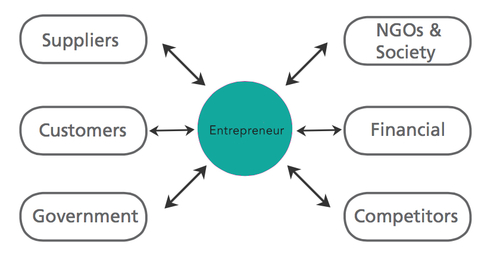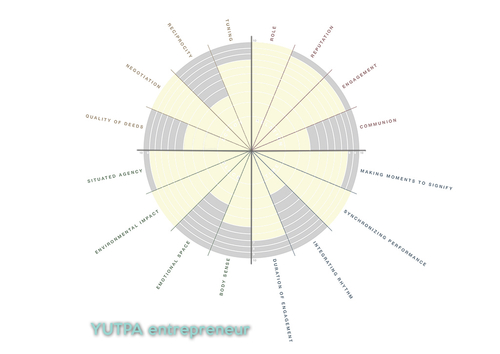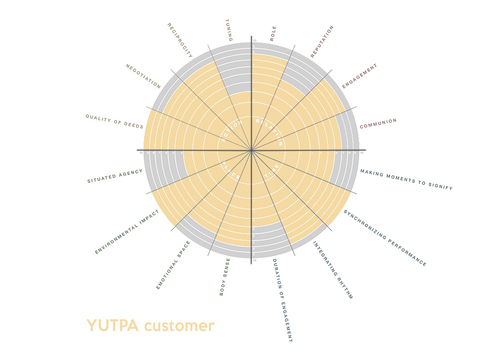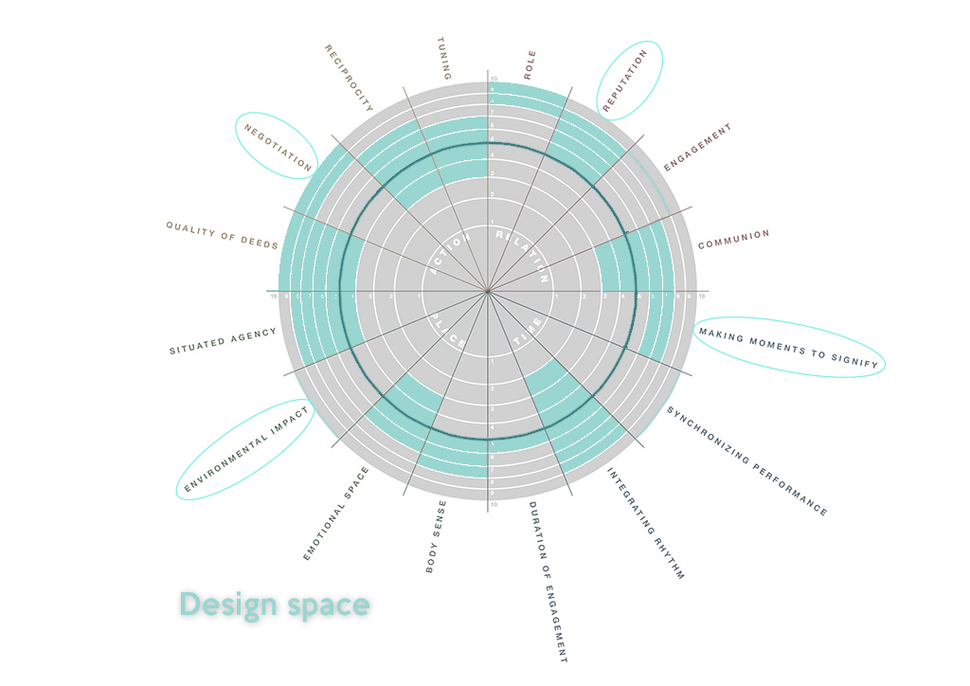stakeholder value chain

- suppliers: providing components or services supporting the final product of your business. Trustful relationships with suppliers ensures product's success and potential of future improvement.
- customers: among other factors interested in the price and functionality of the product.
- government: is generally concerned with improving the competitiveness of its local economy and improving the quality of life of citizens. Government can push development in desired direction through regulations or subsidies; thus setting boundary conditions, but also creating opportunities.
- financial institutions: can provide loans and financial support for setting up and/or expanding a business. The most common institutions are banks.
- competitors: under traditional rules, these are seen as the ones that should be beaten. However, they also have potential to add value through knowledge sharing especially in sustainable development, where the aim is to solve social problems.
- society: although different groups may have different opinions, views and values, the overall aim is to increase welfare and well-being within all layers of society.
As already discussed in chapter 1, the important other side of the coin is the customer. Customers are those who will determine whether or not a product or service will be successful. There is no success without demand. Customers are interested in paying a fair price for the functionality and image purchased and thus must be taken into account seriously while making business decisions (Pascual et al, 2011).
YUTPA: entrepreneurs <-> customer



One of the main reasons why sustainable entrepreneurship often fails is that there are usually very good intentions but at the same time very little knowledge about the problem and about the end user. Understanding the end user's interests, values and perceptions is essential to develop viable solutions to problems and business models. Moreover, as the markets are not homogenous, each segments has its own interests, pitfalls and solutions (Pascual et al, 2011).
While designing a sustainable solution, you need to understand how the problem is perceived from the perspective of the end user; such could be done by observation, desk research (using e.g. concepts of happiness of Kahan (2010) as described above) or involving the end user in the development of the product (done for example in the lean startup methodology, discussed more in detail in chapter 3 (Lean Startup, 2016).
The notion of actually acknowledging the importance of sustainability among customers is an important one to mention. In her book “This Changes Everything”, Klein (2014) addresses the issue of climate change and how the perception of it has been changing in past years. She states that people's opinion on climate change vastly depend on their political beliefs, place of living (e.g. countries whose economies are dependant on oil tend to disprove climate change) and their financial situation. Because the Netherlands is already quite ahead in such awareness (much more ahead than, for example, Canada or the US, as described in Klein's book) the environment for the sustainable development is perceived to be fruitful in Texel. However, there is evidently still a long way to go.
Already established sustainable projects & initiatives in Texel
In this part, we will describe established sustainable projects & initiatives in Texel in the present situation. This could give us an insight on what already works on Texel and what we can learn from these examples to help us map the future situation of sustainable entrepreneurs on Texel.
Energy:
The production of energy from sustainable sources is one of the most common sustainable types of initiatives on the island and beyond. TexelEnergie is the main actor on the island and they provide sustainable energy to both the island and the mainland, powered by sun, wind, biomass, geothermal and tidal. Apart from producing green energy, they support local initiatives to generate their own power. They share the vision of the municipality to ensure Texel being electricity self-sufficient by 2020. Many locals are stakeholders in the company and stay involved in their plans and policies (TexelEnergie, 2015).
Also, a pilot project has been launched by offshore specialists Bluewater to generate power by water currents during tide. 12 entrepreneurships across the Netherlands collaborated to get this project off the ground, including local parties. With the floating platform they are investigating energy production for remote islands. Since they are successful with their results, next steps will be taken within this initiative on the island (Duurzaam bedrijfsleven, 2015).
Local products
A second section that is already established on the island, is the production of local food to sustain lifestyle of the inhabitants and the tourist of Texel. Echt Texel is a mark which represents this group of locally produced products and can be seen as a authentication label towards customers. In return, this label ensures certain demands regarding the locality of the raw materials used and local fabrication of the product. Both of these demands are set to 75% and with this knowledge, customers are able to make sustainable choices based on proven facts. Sustainable entrepreneurs can get access to this label after registration and a background check by this organisation (Echt Texel, 2016).
An example can be given by a local beer brewery called Texels Speciaalbier. Since 1999, they produce their beer on the island using ingredients grown on the island itself. Therefore, the beer is considered a true local product of Texel and since ingredients are so fresh and can instantly be used for beer production, they provide a unique flavour in addition to being only sustainable (Texels Speciaalbier, 2015).
Another great example of a local entrepreneurship is called TexelWool, which provides products such as duvets and mattresses made from wool of Texels sheeps. The special breed of Texels sheep have been inhabiting the island for centuries and are used for TexelWool since 1984. The wool is being further produced on the island itself as well and can therefore be considered a sustainable product which is leading in the wool industry (TexelWool, 2015).
Education
One of the keys to success when it comes to sustainable transition, seems to be the education of people in sustainable behaviour and the platforms to share this amongst others. A good example of this is Kennis & Kunde TX, which represents a platform on which education and labour market get together. The main goal is to strengthen education on Texel and the municipality, in combination with OSG Hogeberg and TOP-Texel, started this project to broaden the spectrum of educational fields on Texel. They hope to be able to attract more young entrepreneurs and highly educated personnel to the island to improve boundary conditions (Kennis&Kunde TX, 2015).
Another local initiative can be found in de Zelfpluktuin. This platform provides the ability for people to collect their own flowers, fruit and vegetables straight from the soil. This way, people are educated in the way these products grow and get aware of the importance of a healthy soil and proper circumstances to grow in (de Zelfpluktuin, 2015).
A third example is a very interesting platform called TexLabs, which is a non profit organisation trying to bridge a gap between local entrepreneurs and students. The locals have the advantage of knowing all ins and outs of the island and (international) students possess very specific knowledge on many different professions. TexLabs is the creative chain linking them together and facilitates local innovation and new start-ups. Apart from that, they provide guided tours over the island to bring groups of students in contact with local initiatives (TexLabs, 2015).
The last thing we want to mention here is Stichting Duurzaam Texel (SDT), which is again a network platform to bring people and knowledge together in four meetings per year. They have initiated and stimulated activities since 2000 which add to the sustainable development of the island, and since 2013 they decided to fully focus on the knowledge platform. This foundation has erupted from a former goal to make tourism less intense for the island, so that tourists can enjoy it for a longer period of time (Stichting Duurzaam Texel, 2015).
Businesses
We also found two businesses in the present system that represent sustainable entrepreneurism in the mainstream sector. The Waddenhaven Texel is a harbour with sustainable principles embedded in their corporate vision. They offer a combination of high quality service and sustainable environmental targets to achieve. Their main goal is to preserve the Waddenzee and the open landscape that goes with it. They thrive for sustainable tourism, ecological preservation, economically viability and social acceptance. They managed to build this new marina by using the material of the old marina as a basis and reused its foundation. They got multiple awards for their efforts over the years (Waddenhaven Texel, 2015).
And then there is Hotelgroep Texel as a second example. They aspire both profit, people and planet and this is shown in the following examples. They installed high performing climate installations in every room and changed all lights to LED’s. Showers and toilets are saving on water usage and their energy is generated sustainable by TexelEnergie. They use a much local products and ingredients as they can and buy other products against fair trade prices. Instead of a petrol car, they use two electric scooters for short trips and they print their promotion material on rest paper (Hotelgroep Texel, 2015).
Eco-system
This system has its focus a bit more on the planet within the triple P approach. In 2009 already, a European initiative started focussing on 10 islands in the North Sea region. Texel and Ameland participated as well and the goal is to showcase sustainable initiatives regarding water, energy and waste. The goal is to create a snowball effect, initiated by these examples, which could have its effect both national and international. Focus within Texel lays on the Cradle2Cradle principle and they see a very important role for banks, who should stimulate young entrepreneurs to initiate and develop ideas regarding the Cradle2Cradle principle. An example is given by collecting plastic garbage from the sea and reuse them for other applications (Duurzaam ondernemen, 2015).
On the other hand, Wageningen University focusses on Texel and their participation in the international “Building with Nature” project. The main goal within this project is to provide an ecologically sustainable development to preserve sustainable living for low-lying delta areas which are subjected to urbanisation, economic development, a rising sea-level, soil subsidence and climate change. Research has shown necessity for innovative ideas regarding coastal defence, like the Sand-engine for the Delflandse kust. There is also a focus on sound pollution in areas where nature tries to find peace and they even monitor the behavior of groups of fish regarding the construction of a new waterway (Wageningen UR, 2015).
Agriculture
When it comes to agriculture, which is a huge market on the island, there is a very impressive example using salt farms for sustainable agriculture. Normally, salty areas are not suitable for agriculture purposes without the usage of fresh water, but Salt Farm Texel provides a solution without this fresh water. They do this by testing and develop salt-resistant flora and the treatment that goes with it for these salty soils. Because of an increasing salination, these techniques can sustain the agriculture sector and protect them from great losses. It gained loads of international attention, since salination is happening on a global scale and this planet’s number of inhabitants will keep increasing over the next decades (Generous Minds, 2015).
Finance
The financing of entrepreneurs can be a powerful instrument to get sustainable transitions moving, green banking. ASN Bank supports sustainable entrepreneurships by financing new projects or investing in established companies. For example, they financed the installation of deep soil energy storage for the Ecomare museum on the island. Not only is this installation a sustainable intervention, but also Ecomare has a sustainable business model. They have also invested money in TexelEnergie, which has already been named in the section of energy. The main focus of ASN Bank, as can be read on their website, is to make the world more righteous and more sustainable via financing, investing, sponsoring, donations, knowledge sharing and stimulating certain collaborations (ASN Bank, 2015).